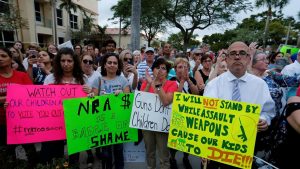What could possibly be new or different about the aftermath of the Valentine’s Day school shooting in Florida, the latest mass killing by firearms in America? Hasn’t everything that had to be said about gun violence in the United States already been articulated in factual reportage, fiction and film?
There has been a bestselling novel, which told the story of a high school massacre similar to Columbine, 1999. There is a film adaptation starring Tilda Swinton of the Lionel Shriver book We Need to Talk About Kevin. Michael Moore first won fame when his 2002 documentary film Bowling for Columbine became a success.
And yet, the Columbine story repeats itself over and over in a loop that is monotonously morbid and grotesquely bloodstained. The Florida shooting was just one more on a list already too long and gory. Really, what is there left to say?
A lot, as it turns out. The students who survived the Florida school shooting, the deadliest in the US since 2012, are chanting “enough” and “not one more” and trying to shame America into a whole new gun debate. They have announced a national “march for our lives” on Washington to demand concrete political action for gun control. They are calling out politicians, including US President Donald Trump, who offer “thoughts and prayers” but little else for victims of gun violence. And they are speaking up against the millions of dollars funnelled into Mr Trump’s and other politicians’ election campaigns by the National Rifle Association, the powerful gun lobby group.
The traumatised Florida high schoolers are being called the post-Columbine generation, born right after the incident that became a deadly precursor for their times. They entered adolescence during the decade that saw five of the most deadly mass shootings in their country. They are internet-savvy enough to know that American gun violence is truly exceptional, its toll and frequency unmatched in any other country not embroiled in a civil war.
Is it any wonder they are talking tough, asking America and its politicians to face the facts? The Florida shooting, as one survivor put it, “isn’t just a mental health issue. He (the shooter) wouldn’t have harmed that many students with a knife.”
Is it possible that the Florida school shooting will be, as the survivors are urging, a turning point?
Hard to say, but this is the first time the post-Columbine generation is trying to find its voice. In the years since the Columbine school massacre by two students, which left 15 dead, including the perpetrators, there has been much activity and almost no real action. After Columbine, school security across the US was improved and police tactics changed to good effect. Metal detectors and see-through school backpacks became a reality, as did terminology such as “lockdown”, “active shooter” and “code red” among America’s children. There have been television and radio talk shows, newspaper and magazine features and academic papers about US gun culture. There has been political blather, canny arguments from the gun lobby, claims, counter-claims — and much blood shed.
Mass shooting statistics are fiercely contested but what cannot be denied is the reality. Young Americans are increasingly affected by gun violence as they go about the innocent business of being children. The day after the Florida shooting, the Washington Post reported the results of its “ongoing analysis”. It said “more than 150,000 students attending at least 170 primary or secondary schools have experienced a shooting on campus since the Columbine High School massacre”.
That is a frightening figure, no matter which side of America’s fraught gun debate one favours. And does it really have to be this way, even for a gun-loving country?
Not if one goes by Switzerland, which has the third highest rate of private gun ownership in the world, behind the United States and Yemen and is so fond of firearms it recently rejected a referendum calling for a national gun registry and for soldiers to store their guns in public arsenals.
But unlike the US, Switzerland hasn’t had a mass shooting in 17 years. It enforces strict regulations to do with gun ownership, has mandatory background checks, rarely issues public-carrying permits and insists guns in transit are unloaded. It helps that Switzerland also maintains a careful list of about 2,000 individuals deemed too dangerous or unstable to own or buy guns. Finally, of course, unlike the US, Switzerland doesn’t have the constitutional right to bear arms.
But if a constitutional right is meant to protect citizens, shouldn’t it make them feel — and be — more secure?
Perhaps the best answer to that difficult question is offered by a young survivor of the Florida school shooting. She summed up the situation for young Americans as follows: “We need to be safe. There’s nowhere to be safe. We can’t even go to school.”
That would be a heartbreaking lament anywhere, whether in in war-torn Syria or the occupied Palestinian Territories. But in the US, a rich, safe and powerful country, it is a travesty.


